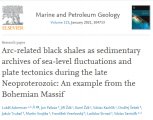Ancient sea-level fluctuations due to vast glaciations
Black shales provide important clues to paleoenvironmental changes of the Earthʼs oceans and atmosphere throughout the geological history. In the Bohemian Massif, black shales were commonly deposited at, or very close to, the Neoproterozoic/Cambrian boundary, also known as the period of “Life Explosion”. The new study led by Lukáš Ackerman of the Institute of Geology and published in the Marine and Petroleum Geology journal (link here) focused on two black shale successions. It revealed that their deposition was intimately connected with the waning activity of a volcanic arc, changes in anoxic-oxic conditions and a global sea level change in response to large-scale periods of glaciation between 580 and ~550 Ma.


